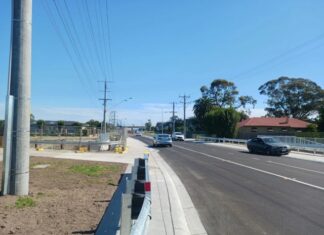By Danny Buttler
MELBOURNE Water has been told to clean up its act or risk a repeat of the floods that devastated the region a year ago.
The Bunyip Main Drain is choked with wattle trees and weeds and is running at only 60 per cent of its capacity, according to angry swamp farmers.
They believe Melbourne Water is refusing to remove the native vegetation for environmental reasons. This is despite pleas dating back to the mid-1990s for the water authority to resume its clean-up works.
“They have requests back to 1995 to have that drain cleaned,” Cora Lynn potato farmer Wayne Tymensen said.
“They used to have people go through every two years or so with machetes and cut the wattle trees.”
At Iona, the drain resembles a wild river with trees and weeds growing vigorously along the banks and in the water. Photos of the drain in the early 1970s show a free flowing water-course with little or no vegetation on the banks.
Without the vegetation removal, the ability of the drain to carry flood waters to Western Port Bay is severely hampered, according to Mr Tymensen.
“That is what caused the flood last year,” he said.
“We had a hydrologist work out that it has reduced the drain’s capacity by 37 per cent … I think that’s very significant.”
Melbourne Water said it has engaged an independent consultant to review the drainage systems, although it has already declared that the Bunyip Main Drain “coped well” with the deluge.
“The flows we saw as a result of the exceptional February rainfall exceeded the capacity of the Bunyip Main Drain, which can withstand up to a 1-in-15-year flow,” Melbourne Water’s south-east waterways manager Rod Clifford said.
“Considering the extreme conditions we believe the drainage systems coped well but we also understand the frustration of farmers who were flooded.”
In a statement issued to The Gazette, Melbourne Water made no reference to clearing away vegetation from the drains, saying only that it would consider recommendations from the Cardno flood report.
“The Cardno report will investigate the issue of vegetation in drains and include flood modelling for the area,” Mr Clifford said.
“The review is being finalised and will be released to the Kooweerup Advisory Committee in February.
“Once the report is released, Melbourne Water will work through any suggestions to understand what works could be undertaken and how these might be funded.”
But local farmers, who saw their year’s work washed away in last February’s floodwaters, believe Melbourne Water has forgotten why the drain was orginally cut out from the swamp back in the 1930s .
Cora Lynn potato grower Frank Rovers said trees have been allowed to grow for so long that Melbourne Water now needs permission from the Federal Government to cut them down.
“The drain has a purpose, which is to protect the swamp, and it’s not doing its job,” he said.
“They are starting to see it as a wildlife link and that is not what it is about.”
Mr Rovers said a repeat of last year’s floods could see farmers seeking compensation through the courts.
“Legal action is based on someone being negligent and they are being negligent.”
For local farmers, the issue isn’t about damage to individual properties or crops but is about securing the future of valuable farming land.
Mr Tymensen believes the entire Bunyip Food Bowl strategy is being placed in jeopardy by the drainage issue.
“It’s about the future of the district and that drain is a big part of it,” he said.
“We need to remember that it is a drain, not a river.”
Get the latest news to your email inbox FREE!
REGISTER





